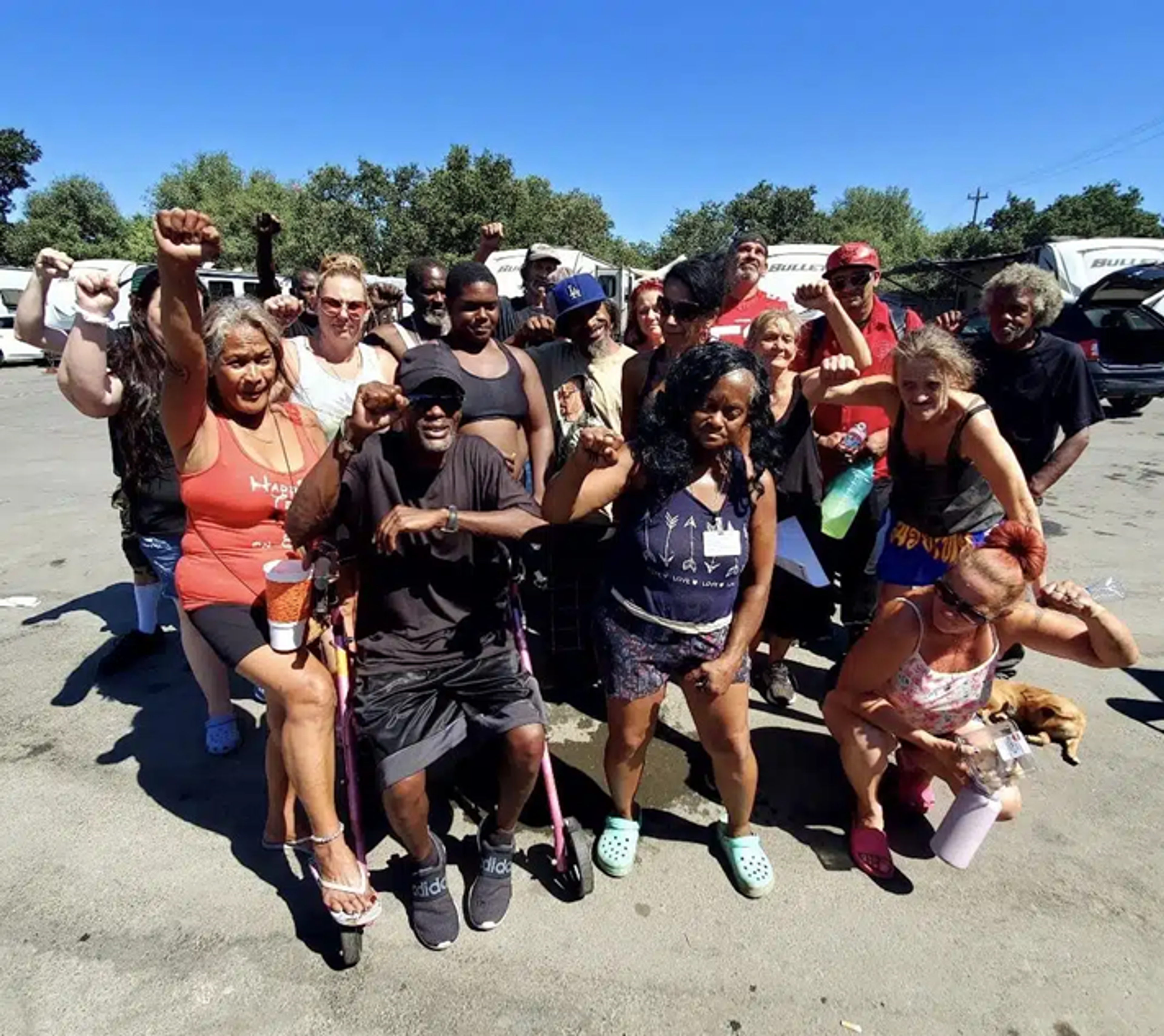Sacramento encampment residents thought they’d found stability. Why did their lease fall apart?

Courtesy of Shelterforce
By Roshan Abraham
- News
Until last summer, around 50 unhoused people lived in a fenced-in plot of land owned by the California city of Sacramento. The site didn’t have running water or electricity, the soil was contaminated, and city officials had threatened to remove the campers and their belongings from the lot. But it was the only home that the residents—who were mostly disabled women—were able to find, and they were prepared to stand their ground and fight for it.
Their resistance was enough to get the city to agree to a historic lease with the homeless camp—dubbed Camp Resolution. In spring 2023, Sacramento offered the residents city-owned trailers and guaranteed use of the lot as a “safe parking site” until each resident secured “individual, permanent durable housing”.
Resident-run encampments that are city-sanctioned or supported are rare. The Sacramento Homeless Union believes that the Camp Resolution lease was the first to include a guarantee that the lease would be renewed until the residents secured permanent housing.
The lease was a breakthrough for homeless organizers and showed a different way forward outside of the framework of homeless sweeps and perfunctory offers of services.
Encampment sweeps can lead to the loss of belongings and the dissolution of networks of care necessary for survival. At Camp Resolution, residents say that they had an accessible place to stay without having their belongings swept, which allowed them to care for one another, build community, and self-govern without the burdensome rules that come with living in homeless shelters.
But a little over a year after it was first signed, the lease was dissolved. Camp Resolution has since been swept, leaving residents scrambling to find stable, accessible housing.
Some found temporary housing in shelters, but many remain unsheltered. At least one resident, Shonn Adams, died a few months after the sweep, according to the Sacramento Homeless Union.
Here’s how the lease fell apart, and where residents have gone since.
How it started
In 2021, Sacramento officials first chose a 2.3-acre lot on Colfax Street as a potential spot for a city-sanctioned tiny home shelter, but the proposal ran into a jumble of complications.
In January 2022, the city’s water board approved the lot through 1 June 2024 as a safe parking site for people who live in their vehicles. California cities have created many of these sites, which offer legal protection from towing and sanitation services for the growing population of people living in cars and trailers.
The site was approved on the condition that vehicles remained in a fenced-in area and no tents were staked, because of harmful chemicals in the soil. The Sacramento City Council then changed tack, deciding it did not support the safe parking project because it “had become cost prohibitive”.
But in late September 2022, a group of unhoused people (mostly disabled and women) began to occupy the lot, seeking a stable space for a quadriplegic unhoused woman named Holly Porter.
“We said, enough is enough,” Crystal Sanchez, president of the Sacramento Homeless Union, tells Next City/Shelterforce. “The people kept getting swept off the lot so they could prepare this lot to be something, and then it was never anything. And so a group of us took this lot back and said, ‘We’re standing our ground.’”
The group found comradery in the Sacramento Homeless Union and its parent organization, the National Homeless Union, which provided legal support. After neighbors defended the encampment at a city council meeting, the city reached an agreement with the camp in March 2023. A nonprofit called Safe Ground Sacramento, which works with homeless encampments in the area, agreed to be the lessee representing Camp Resolution.
The lease was designed to last for 120 days and automatically renew for another 120 days afterwards, absent any substantial breach of its provisions or agreement by Safe Ground Sacramento to terminate. If there was a breach, the city agreed to provide 15 days’ notice and the ability for residents to address the problem. The agreement protected residents from homeless sweeps, which break up found communities and make it more difficult for people to secure permanent housing.
In addition to losing belongings including identification, clothing, and medication in homeless sweeps, unhoused people lose networks with other unhoused people who provide support during sweeps and can miss doctor’s appointments or fall out of touch with social workers. The lessee agreed to a number of conditions, including complying with the water board’s variance terms and paying for their own utilities.
Unlike city-ordained encampments, Camp Resolution was run by its residents, Sanchez says. Neighbors brought them water. There were no power hookups in the lot, so residents partnered with Sacramento Environmental Justice Coalition, a local organization that brought in a solar trailer from the Footprint Project, which builds solar arrays for disaster relief.
“It couldn’t power the whole thing … but it was able to run fans for everybody. We were able to charge phones,” Sanchez says of the arrangement. “We’re talking about 48 people who have zero access to money, they’re unhoused.”
After much advocacy, Porter secured permanent housing a few months after Camp Resolution’s lease was signed. Other residents would not be as successful, despite the original intent of the lease.
Political pressure builds
As in much of California and the country, anti-homeless politics have been growing in Sacramento.
The city passed Measure O in 2022, around the time that the occupation began, and it took effect in June 2023, a few months after Camp Resolution’s lease was signed. The law forces the city to take action against “unlawful camping” or “unlawful storage” on public property if a resident files a complaint. The law also requires the city to expand its emergency shelter space so that beds are available to people who are affected by homeless sweeps.
In November 2023, Sacramento’s District Attorney threatened to sue the city and Safe Ground Sacramento, claiming that the property was a health risk and that residents were using tents in violation of the lease agreement.
Safe Ground Attorney Mark Merin lamented to the news agency KCRA that he was seeing lots of “hand-wringing and arm-waving, but not money” from the city. In April of 2024, the city sent a letter to Merin with a notification of the impending expiration of the water board’s temporary permit and said that residents had to leave the camp in two weeks.
The initial deadline for clearing the camp came and went. In June, the Supreme Court ruled that it is legal to sweep homeless encampments even if there is no available shelter. Governor Gavin Newsom immediately announced that he would restrict funds to cities in California that did not sweep their encampments, adding to the political pressure to end Camp Resolution.
In late July, Safe Ground Sacramento agreed to terminate the lease, effective 10 August.
Because Safe Ground Sacramento, the lessee, agreed to end the lease against residents’ wishes, the residents felt cheated out of the permanent housing that they had hoped to find while the lease was in effect. They rebuffed the city’s offer of temporary shelter, including the relocation of the entire camp and motel stays. Safe Ground Sacramento did not respond to a request from Next City/Shelterforce for comment on this termination.
Anthony Prince, lead organizer of the National Union of the Homeless, says that when residents asked whether permanent housing would be guaranteed if residents relocated, the city provided no such assurances, so residents voted to reject the offers.
The city announced plans to sweep the encampment in late August. “People were panicking,” Sanchez says. “We weren’t really sure if they were serious,” because previous deadlines had come and gone.
Seeking accommodations
About a week before the sweep, Prince sent the city’s ADA coordinator formal requests for “reasonable accommodations” under the Americans with Disabilities Act for 30 camp residents. Each request included a letter from the applicant describing their physical and psychiatric disabilities. The union believes that the city is legally required to provide shelter that is accessible under the ADA. Prince also asked that the impending 26 August sweep be canceled while the city processed the requests.
Prince says that he did not receive a response from the ADA office, but says that Senior Deputy City Attorney Sean D. Richmond and City Attorney Susana Alcala Wood denied all 30 requests. The city officials said that the Sacramento Homeless Union had been made aware of the upcoming sweeps and should have been prepared.
Residents were offered placement in cabin shelters at the city’s Roseville Road site. The city calls the site accessible, but Prince and Sanchez say that that is not true. In a 25 August legal complaint filed on behalf of the National Union of the Homeless, Prince attested that city officials told them there were no disability accommodations at either Roseville Road or another shelter being offered.
Sanchez said that nine encampment residents called 211 on 23 August to request shelter space, per the city’s notices posted in the camp, but they were told that no space was available. When Next City/Shelterforce inquired about residents of Camp Resolution who were not found housing, the city deferred to its press releases about the sweep.
The complaint includes a letter from Disability Rights California, a state-designated nonprofit entity that protects disabled Californians’ legal rights.
“While residing at Camp Resolution, [the residents’] disability-related needs have been finally met through community resources and the help of their neighbors, and by their own individual measures,” the letter says. “We are especially troubled that the proposed shelter at the Roseville Road campus will not meet the disability-related needs of all Camp Resolution residents with disabilities.”
Sanchez said that Shonn Adams had a seizure on 25 August, the day before the sweep, while putting her belongings into storage. Another resident, Jeanne Gillis, suffered from regular seizures; Sanchez said that none of the city’s shelters could accommodate her because they were highly restrictive on the movement of residents and would make community support difficult.
The city did connect some residents with temporary shelter, but it was not able to connect anyone with permanent housing and did not have homes or accessible shelter placements for three people who were the most high-risk, Sanchez says.
The sweep
On 26 August, around 7am, the sweep finally arrived.
The gates for the property were locked when between 30 and 40 sheriffs’ cars arrived, Sanchez says. Local media showed up, including TV crews and the Sacramento Bee. By then, most of the residents had moved, Prince says. The 15 to 20 residents who remained, he says, were the most disabled and the union was still trying to relocate them.
Prince says that police cordoned off the entire area and declared it a crime scene. “I’ve been in sweeps, hundreds of sweeps, over 30 years, and I’ve never seen one declared a crime scene,” Prince says. When he asked what crime had been committed, an officer replied, “Trespass,” he recalls.
A representative with the City of Sacramento confirmed this in an email to Next City/Shelterforce, saying, as of 26 August, that “the occupants of the camp were in violation of the trespassing provisions of the Penal Code.”
According to public statements and other reporting, lawyers and journalists who were at the scene were deliberately kept out of the lot while sweeps took place, making it impossible to record what was happening in real-time.
A statement from the National Lawyers Guild took issue with the amount of resources expended on the sweep: “For Camp Resolution residents, the City of Sacramento chose surveillance helicopters over running water. Tow trucks over electricity. Police overtime over toilets. Bobcats over showers. Code enforcement over disability services,” the Guild’s statement said.
Julie Hall, a communications specialist for the city of Sacramento, said in an email that keeping observers out was a necessary safety measure. “Maintaining that perimeter was a key element to ensure that the camp was secured, to provide for the safety of everyone involved, to prevent any interference with ingress and egress,” Hall said.
Even though the water department was not renewing its variance for the city to use the location as a safe parking site, the city published a press release accusing the Sacramento Homeless Union of lease infractions. In one instance, the city says that the union blocked the entrance into the camp for a fire inspection.
Prince says that the dispute was over whether the camp had proper notice of the inspection; residents also feared that it was an attempt by the city to find a lease violation. The fire department eventually conducted the inspection, finding several fire code violations that residents fixed to the department’s approval within a few days. Next City/Shelterforce reviewed an official Sacramento Fire Department notice as well as an email from the city’s Fire Marshal Jason Lee that confirm this. The city press release does not mention that the camp passed its inspection soon after the incident.
The press release also says that the city will enforce its unlawful camping ordinance in the future, “as allowed under the Supreme Court’s recent Grants Pass ruling.” (The city’s camping ordinance, which requires that the city find adequate shelter before conducting homeless sweeps, was already enforceable before the Supreme Court decision.)
Sanchez says that people with trailers were not permitted to tow their own belongings. The city towed their belongings instead, as well as the city-provided trailers. In a 30 August press release, the city said that registered owners of vehicles should contact the Sacramento Police Department, and that anyone who wanted to recover their items from city-owned trailers should call the city’s Department of Community Response. It said that city-owned trailers would be stored for 60 days for residents to retrieve their belongings.
But for resident-owned trailers, Sanchez says, the city failed to log each trailer with its owner, and the trailers went to multiple locations. Some people who located their trailers found they were in private impound lots, she says, and by the time that they tracked them down, the impound fees were too high for them to get any of their belongings.
“There’s still some people who we were never able to determine where their belongings went,” Sanchez says. When contacted for comment, the City of Sacramento referred Next City/Shelterforce to its 30 August press release.
The aftermath
In its press release two days after the sweep, the city said that 13 people were relocated to motels and shelters.
Three months after the sweeps, Sanchez said that many people who were in the camp were still without stable residence. Some left Sacramento. Some moved in with family. A few secured apartments. Throughout the process, Sanchez says that the city has been “completely unresponsive,” even though most encampment residents were disabled.
Sanchez says that the city particularly failed some of the most high-risk residents, who need shelter that accommodates their disabilities. Resident Shonn Adams, 55, died in early December, a little over three months after the sweep of Camp Resolution, according to the National Union of the Homeless.
Adams did not want to die on the street, Sanchez wrote in a Facebook post, and thanks to Camp Resolution community members, she did not. Though she died in a temporary motel arrangement and was weeks from moving into a new apartment, both had been secured by fellow encampment residents rather than the city, the homeless union says.
In an email, Hall, the Sacramento spokesperson, said that the city’s Department of Community Response found Adams an ADA-compliant motel room for her and her partner, but the motel operator refused to take in Adams’s pit bull. “Ms. Adams was unwilling to part with her dog and ultimately declined the City’s offer,” Hall said.
Prince says that none of the rooms in the city’s motel program would have accommodated Adams’s disabilities. In Adams’s letter requesting accommodations before the sweep, she had written that she had HIV, congestive heart failure, a broken ankle, chronic pulmonary disease, and had to use an oxygen tank 24/7.
Prince also said that Adams’s pet pit bull was necessary for her safety, noting that dogs offer protection from assault for many people experiencing homelessness.
“No matter where a homeless person may find temporary refuge, they are always at risk for being pushed back into the streets where, in the case of Shonn and many other Camp Resolution residents, they would need protection,” Prince says.
Sanchez says some Camp Resolution residents who’ve returned to the street have been sexually and physically assaulted. She is still working on finding safe shelter space for several residents including Jeanne, who has chronic seizures and suffers from memory loss, and Betty Edwards, who is on dialysis.
Despite the resources expended to reclaim the lot on Colfax Street, the city of Sacramento has now declared it “surplus land” and plans to sell it. According to an October 2024 resolution, the lot “is not necessary for [the] City’s use and is not designated for any current or future City projects.” There is no indication that it will return to the approach it took to Camp Resolution in the near future.
But the National Union of the Homeless still sees the encampment as a victory for what it showed was possible: forcing the city to come to the table and make a promise that residents could stay where they are until they found permanent housing, a commitment that unhoused people rarely receive.
Since it was first cited as a space for shelter in 2021, the only period in which it fulfilled this purpose was when Camp Resolution residents made it happen. “The way that we feel is that the homeless union and the residents of Camp Resolution showed up the city,” Sanchez says.
This story was published through a collaboration between Shelterforce and Next City. Next City is a nonprofit news outlet that publishes solutions to the problems that oppress people in cities, inspiring social, economic, and environmental change through journalism and events around the world.
Disclosure: Next City board member Allison Joe was a Senior Advisor for Sacramento Mayor Darrell Steinberg at the time of the dissolution of Camp Resolution. Board members hold no influence over editorial decisions.
This article was originally published in Shelterforce.
Courtesy of Shelterforce / INSP.ngo


